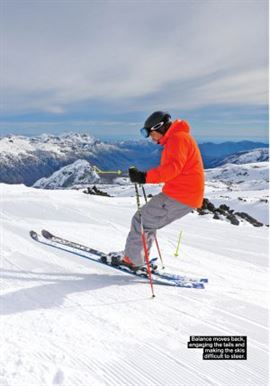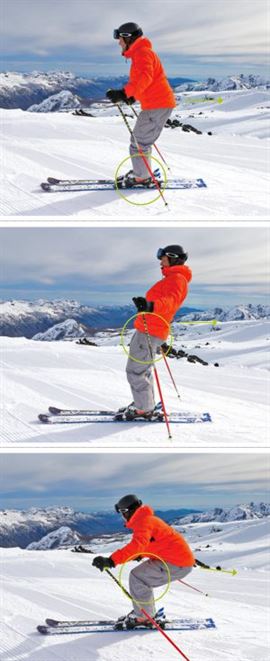Do your skis take off like a rocket, faster with each turn? Although controlling speed is the first thing a new skier learns, even the experts sometimes experience “jet skis.”
Most skiers understand how turn shape can manage speed and that refined steering skills are key to keeping things under control. While turning your legs to twist the skis across your momentum may seem like a simple concept, many skiers still struggle to achieve it because the root cause often lies somewhere else: with fore/aft balance.

If you’re having trouble keeping speed under control, check to see whether your body’s mass is keeping up with your feet as the skis enter the fall line. When you get caught “in the back seat,” the stiff tails engage and make steering nearly impossible.
by TOBIN LEOPKEY, CSIA IV, CSCF II, CSGA I in the December 2017 issue
Photos NIGEL HARRISON
snow VALLE NEVADO and NEVADOS
THE CHILLAN, CHILE
Staying centred requires that you anticipate when your feet will speed up and proactively pull them back underneath you. Doing this effectively requires mobility in several joints, and if any one of them lacks mobility or moves excessively, it can cause an imbalance. Balancing through the middle of the skis’ sidecut will help to take advantage of its design and facilitate better steering. On a slippery surface like snow, we all acknowledge that our feet will take off when we point them down the hill, but because our feet also tend to slow down when we steer across the fall line, there’s a constant speed-up and slow-down cycle throughout the course of a turn that can make fore and aft balance hard to predict.
Look at the movement patterns to see if they could be causing your skis to jet.
Cause
Overextension (plantar flexion) of the ankles can move balance to the tails of the skis.
Solution
If you feel your calves on the back of the boots when your skis take off, aim for more shin pressure on the front of the boots at that moment instead.
Cause
Overextension of the hips can also cause you to get caught behind.
Solution
Push your hands and shoulders forward and keep a tight core so your shoulders stay over your knees.
Cause
Overflexing the knees is a common cause of balance moving to the rear, especially at the end of the turn.
Solution
Rather than moving your hips down and back, move them laterally to tip the skis on edge. Think of bending just one leg to keep your hips more in line with your heelpieces rather than bending both legs and dropping your hips behind your heelpieces.
Pulling your feet back under you (before they take off) will keep some pressure toward the tips of the skis and help them steer through the arc. It may feel like the tips are leading you through the turn.
Just be careful not to pull your feet so far back that your body mass gets ahead, or you’ll end up with a downstem (see “Do You Downstem?” in SC‘s Fall 2017 issue).
Tobin Leopkey is Program Director at Section 8 Snowsport Institute. Tobin, and partner Nigel Harrison, offer ski improvement camps for intermediate and expert skiers in all terrain and conditions in B.C., the Alps, Japan and Chile.




